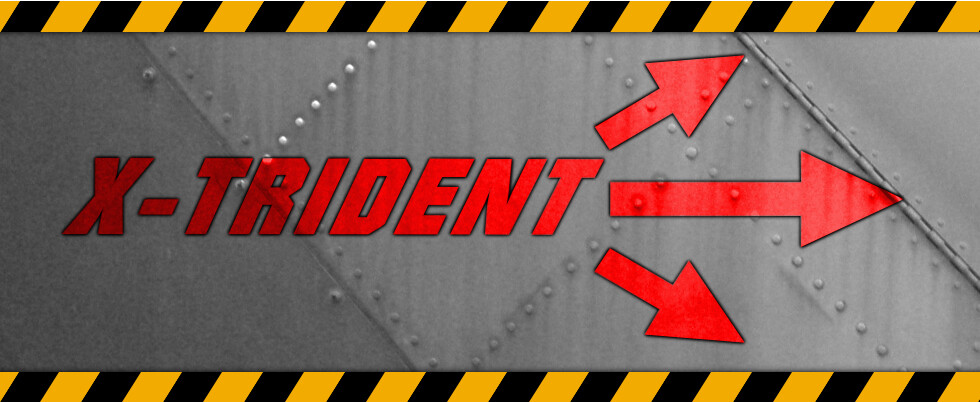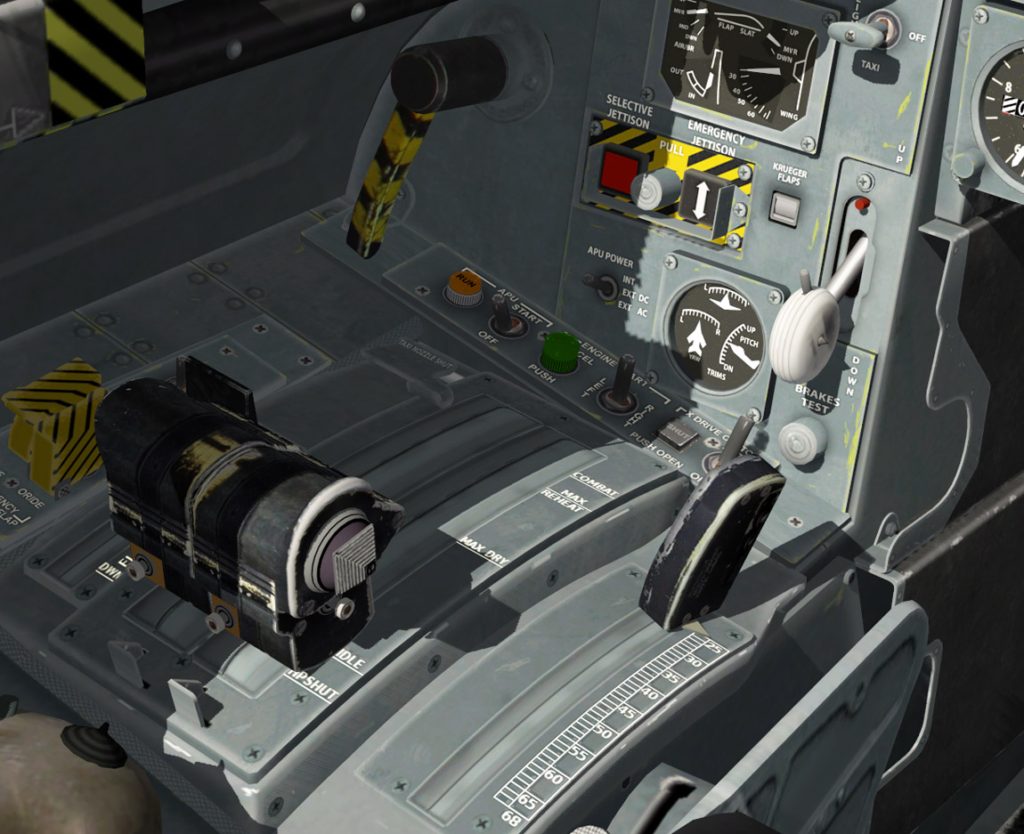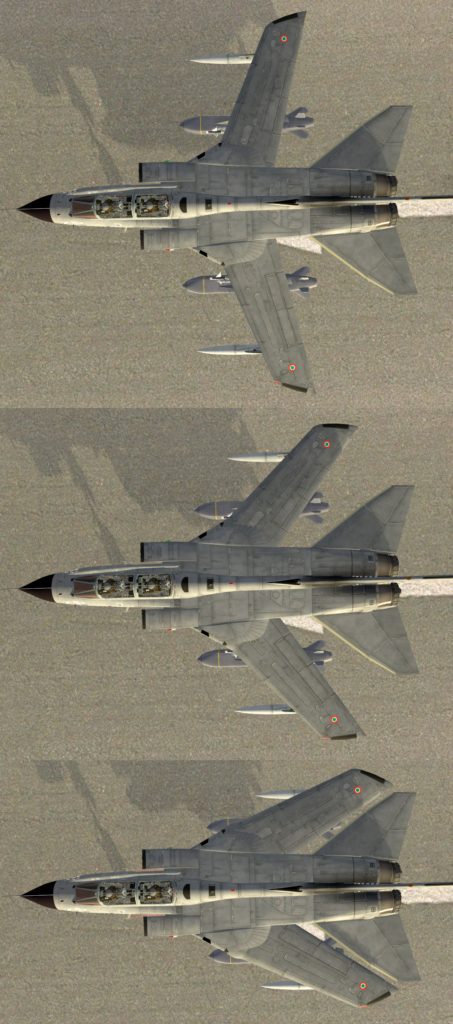X-Trident Panavia Tornado
By @BeachAV8R - March 25, 2017
Originally published at: Articles - Mudspike Forums
X-Plane third party developer X-Trident tackles the iconic Panavia Tornado with the latest release in their lineup. Tuck your wings back, engage the terrain following radar, and hang on for a wild ride!
Those of you that have been following Mudspike over the past couple of years know we are big fans of X-Trident. They’ve brought some impressive military simulation into the admittedly civilian oriented X-Plane world, and they never disappoint with their creative use of plug-ins that add functionality and realism to their aircraft. Back in May 2015, I took a look at their AMX International fighter for X-Plane - an aircraft that impressed me with its fun flight model that was highly variable based on loadout and fuel weight. As well, they have a superbly detailed Bell 412 helicopter that we raved over, and which has been continuously improved over the years. Fans met the news of the Tornado development with great excitement, knowing full well that the team at X-Trident would put a lot of work into making it an exceptional add-on for X-Plane. Though the Tornado is still having some additional work done on it, the results thus far are fantastic.
As you can see from the images, the external model detailing is exquisite. The most recent version (v1.1) includes ten diverse liveries from countries that operate the Tornado, with additional liveries being made and released as requests come in. As a sim pilot, I was enthralled by the Tornado in the classic Digital Integration sim of the same name. With fresh memories of the news stories of Tornado pilots plying their trade across the sands of Iraq at perilously low levels, the Tornado was an iconic aircraft from my youth. X-Trident chose to model the Tornado IDS (Interdiction/Strike) and as such it has a nice complement of air-to-ground weaponry available at various levels of modeling.
Initial impressions
Bringing the Tornado to life from the cold & dark state will require some study of the manual and adherence to the checklist. I was not able to find a cold & dark video online, but it would be a nice addition by the developer to get users past some of the hurdles of finding their way around the front and backseat of the Tornado. Yes, the back seat is modeled as well. The 87-page User’s Manual is nicely formatted, contains excellent cockpit layout photos and graphics, systems descriptions, weapons control descriptions, performance charts, and sim specific settings that describe the functions of the plug-ins that make many of the complex tasks X-Trident modeled in their Tornado work. The full Start-Up and Pre-Taxi checklist runs about 65 items, and is predominantly handled from the front cockpit with the exception of some MFD and weapons panel selections. An additional 23-page Quick Start guide gives you a quick and dirty method to familiarize yourself with the aircraft if you are entering a “hot” cockpit, but there are some HOTAS controls you’ll probably want to spend some time mapping to get the most out of the modeled systems.
The cold & dark options include menu selectable items such as engine inlet plugs, exhaust covers, pitot covers, arming pins, canopy stand, boarding ladder, and ground power unit.It is worth mentioning here - the Tornado was developed for X-Plane 10, and although some work has been done toward bringing it into X-Plane 11 compliance, it doesn’t make a lot of sense to chase a moving target as Laminar continues to add features and squash bugs in the X-Plane 11 beta. It is currently flyable in X-Plane 11, but weapons functionality and some other items are missing. So for now, the full experience is available in X-Plane 10.
Not every button, knob, and switch is functional in the cockpit - indeed, I’d call the X-Trident Tornado more of “The Tornado Experience” because it models important items that give you a window into what being a Tornado pilot must be like, but it doesn’t delve into what I would call study levels of simulation. While some of the HUD modes and weapons delivery options are modeled, this isn’t an exhaustive Tornado simulation, but it does have enough meat on the bone for enthusiasts for sure.
Powering up
The aforementioned checklist will get you up and running with a bit of hunting around the cockpit. The sounds of the APU, engines coming to life, and the distinctive “zip” sound of the thrust reverser doors slamming shut are impressive. A taxi thrust limiter switch is modeled, and should be flipped up to reduce taxi power available. A careful study of the throttles is warranted, since there are several detents and flight stages, as well as the unique left and right throttle rocking switches that set the Lift Dumpers to automatically deploy on touch-down (left throttle rocker), as well as automatic thrust reverser deployment (right throttle rocket). As well, the wing sweep lever can be mapped to an axis on your HOTAS, or you can choose to have it increment to the most often used settings. The sweep angle is variable between 25° (full forward) and 68° (fully swept aft). The wing sweep is mesmerizing to watch and you can feel the wing loading change as the wing moves. Flap and slat settings are also selectable based on your flight regime, however flaps cannot be deployed with the wings swept beyond 25°.
As with most X-Plane aircraft, taxiing the aircraft is a pleasure. XP11 has brought some additional tire friction modeling that works via a whole bunch of Austin’s programming magic that simulates some wheel flex and friction qualities that add even more realism. You’ll find the Tornado sways nicely, the nosewheel tracks accurately, and the nifty thrust reversers are a never ending source of amusement while taxiing.
Onward and upward!
My first few flights I conducted with a clean aircraft (no weapons or pods) and as I learned a bit about the aircraft I started trying different configurations. On initial power application, the afterburners rocket you down the runway and the forward swept wings, flaps, and slats will get you airborne in fairly short order. As usual, I put the Tornado at my home flight test airport (KMUD) where I have some runways laid out with known distances and I ran a few tests to compare how the plane fared at various weights.
-
60,000 lbs. (max takeoff weight) - 4,000’ takeoff roll, liftoff at around 165 knots, landing distance with max braking and reverse of 4,000’.
-
38,000 lbs. (1,000 lbs. of fuel) - 2,500’ takeoff roll, liftoff at 135 knots, landing distance 2,800’.
As you can see, there is a significant difference based on weights. I think with a bit of practice I could get the landing numbers down even further, but the tests show that the Tornado has quite good short field capabilities. Various literature pegs the Tornado required field length at around 900 meters, or roughly 3,000’.
I didn’t do a lot of high speed testing, but I was able to attain Mach 1.52 at FL370 - I believe the ADV (Air Defense Variant) was capable of Mach 2+ speeds, but don’t quote me on that. At high Mach speeds, you will be gulping enormous quantities of fuel, so those sprints will be relatively short lived. The sight of the Tornado in its arrowhead-like, fully swept back wing configuration blasting across the terrain is really cool though.
I was interested to test out the handling characteristics of the aircraft in various wing sweep configurations, so I performed some tests with the initial conditions of 220 knots airspeed, at 10,000’, and noting the AOA and power required to maintain level flight, then gradually reducing power until achieving a stall. The results were predictable - with the forward swept wing (25°) having the most forgiving performance.
-
25° sweep (full forward), AOA 6 units at 85% power to maintain altitude, stall at 110 knots at 22 units
-
46° sweep (mid sweep), AOA 8 units at 89% power to maintain altitude, stall at 130 knots at 22 units
-
68° sweep (full aft), AOA 10 unites at 92% power to maintain altitude, stall at 160 knots at 22 units
I am not sure how close to book performance these numbers represent, but they seem to be what one would expect. One additional test was performed in the landing configuration, with gear down, slats and flaps extended fully, and resulted in a stall at 105 knots at 22 units AOA. Note - these tests were performed with the SPILS (Spin Prevention and Incidence Limiting System) switch ON. One final test I did was a single engine Vmca test - just out of curiosity of what would happen. With one engine at idle, and the other at full afterburner, rudder authority ceased at 70 knots and 35° of pitch, after which the airplane rolled into the dead engine.
[caption id=“attachment_7261” align=“aligncenter” width=“680”]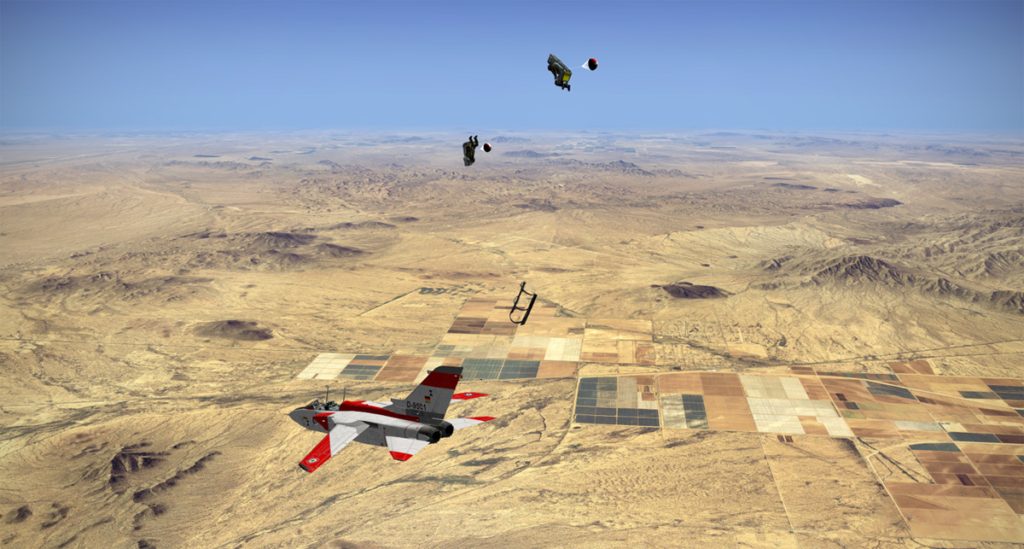 Punching out after exhausting all of my fuel during high speed runs over the test range…[/caption]
Punching out after exhausting all of my fuel during high speed runs over the test range…[/caption]
How low can you go?
There is an oft told story in aviation where the steely pilot brings his aircraft back to base and turns it over to the maintenance chief, commenting that there is a bit of damage to the leading edge of the wing because of a bird strike. After investigating the damage, the chief summons the pilot back to his office and asks if the bird was still in its nest since he also found pieces of wood embedded in the wing. It probably didn’t happen, but it’s a great story anyway.
Fortunately, the Tornado was made to go low, and it was designed to help you do so…errr…somewhat safely. Equipped with a forward looking Terrain Following radar (TF), the Tornado has the ability to fly a terrain hugging profile on the autopilot at high speed. The thought was that the Tornado would penetrate Soviet air defenses with a low altitude, high speed dash, strike the target, and exit in similar fashion. The guys at X-Trident managed to achieve this functionality with some sort of programming magic that must sample the elevation of the terrain data ahead to create a psuedo TF radar display. This is a really, really cool function that shows up on the TF radar display, and you can also show the radar returns on the center map display. If you create a properly formatted topo map as your display, you’ll see the TF radar returns match up with the terrain on the map. It is very cool.
A pop-up autopilot panel makes many of these functions easy to set - and include options for terrain clearance altitude (200’, 300’, 400’, 1000’, etc.), and TF “ride” settings of soft/mid/hard that set the G-loading of the pitch maneuvers during the flight. The manual extensively describes the TF radar display, but generally speaking, the radar plots the terrain ahead and once an obstacle enters the Zero Command Line on the radar, a pitch maneuver is started. Emergency pitch up maneuvers can also occur, and certain conditions such as very high speed, high wing sweep, and too low of TF settings or too soft a ride setting can result in you impacting terrain, so monitoring the TF radar is important. In my testing, it worked beautifully and it was really cool zipping across the canyons and peaks of Arizona at 200’ while taking in the scenery. Doing it in poor weather, at night, while people are shooting at you would be an immensely stressful endeavor, and my hat is off to the pilots that do this regularly - in my opinion it is up there with carrier landings as some crazy aviation stuff. Due to what I assume is limitations as to how much data the plug-in can sample from the map, I believe the radar only functions for a few miles out in front of the aircraft, but I’m not positive on that (picking a further scale would not paint mountains beyond a few miles).
[caption id=“attachment_7262” align=“aligncenter” width=“680”]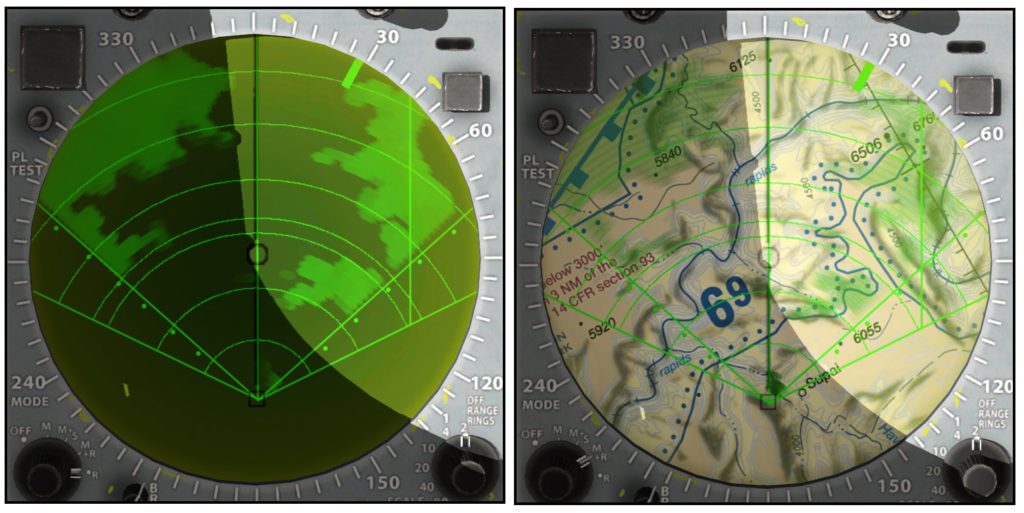 The radar showing the raw radar return on the left and also superimposed on the sectional/topo map on the right.[/caption][caption id=“attachment_7263” align=“aligncenter” width=“680”]
The radar showing the raw radar return on the left and also superimposed on the sectional/topo map on the right.[/caption][caption id=“attachment_7263” align=“aligncenter” width=“680”]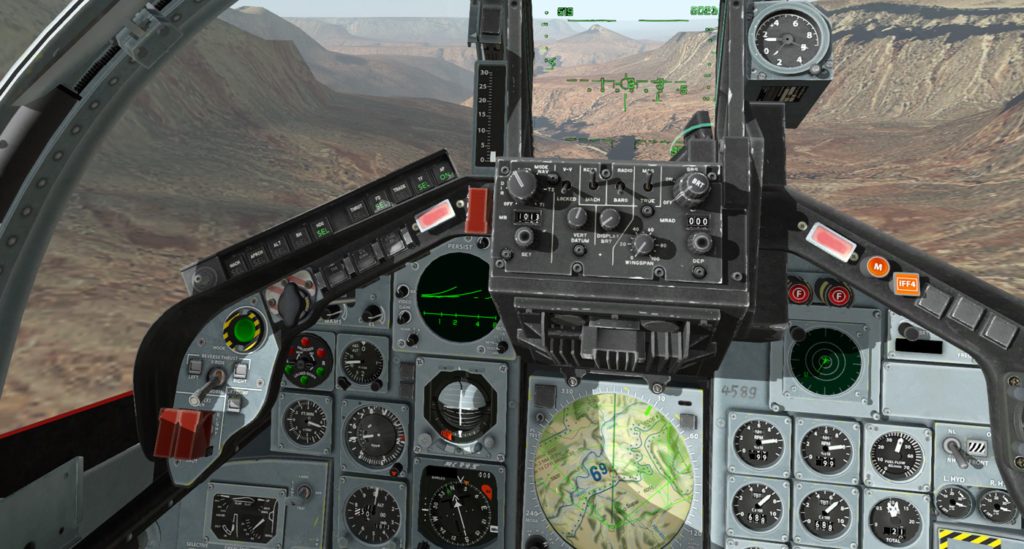 The view out of the cockpit of that terrain depiction.[/caption]
The view out of the cockpit of that terrain depiction.[/caption]
[caption id=“attachment_7267” align=“aligncenter” width=“680”]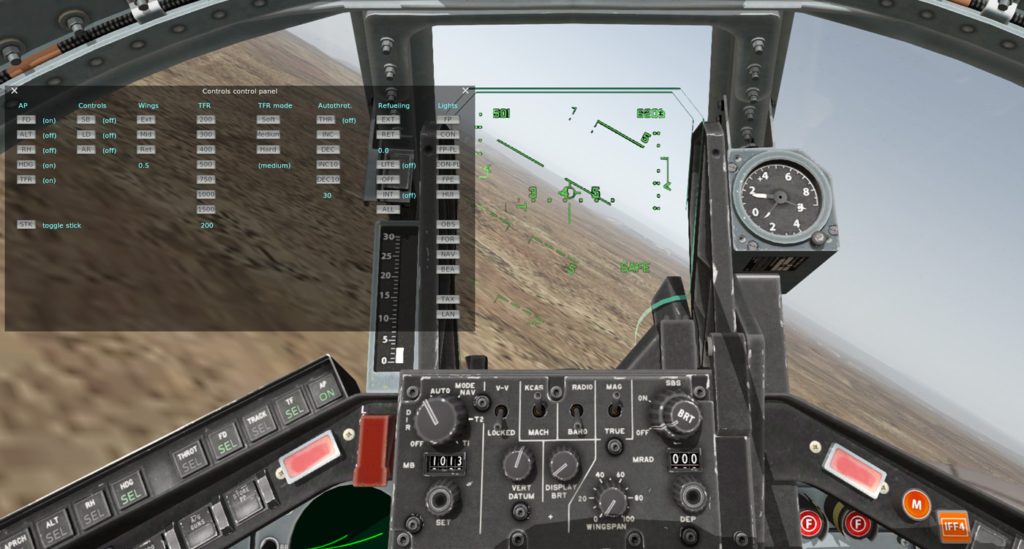 Easy access to autopilot, terrain following controls, auto-throttle, refueling configuration, and aircraft lighting via a pop-up menu.[/caption]
Easy access to autopilot, terrain following controls, auto-throttle, refueling configuration, and aircraft lighting via a pop-up menu.[/caption]
It is also worth mentioning that the other autopilot modes such as altitude hold, heading, track, and approach mode all work well.
Tanking
Of course, with all that low altitude, high speed flying, you might need a bit of juice to get you back to your base. Again, X-Trident stepped in with a really nice plug-in component that lets you call up a custom Tornado buddy-tanker that they provide. You can even put it in a holding pattern, adjust it’s speed, and altitude to meet your requirements. There are various difficulty settings, but I stuck with the most difficult and you really do need to put your basket right near the probe for a few seconds and then it will snap into place and the fuel will flow (if you have your refueling valve switches open). It is a fun and beautiful process that never gets old (until your shoulders start to ache anyway!).
Weapons
The X-Trident is capable of carrying an array of weapons with various levels of functionality (some are still being worked on). The list includes: JDAM, Snakeyes, Mk82/83, GBU-16, ALARM, Storm Shadow, Kormoran, AIM-9, fuel tanks, and the internal gun. Weapons can be set up from the rear seat Weapons Control Panel to include launch parameters such as normal/jettison mode, type, quantity, interval, single/double/sequence, and fuzing. Weapons will release and guide to targeted aircraft or ground targets, but X-Plane isn’t a dedicated combat simulation, so expect some concessions. Straight-forward CCIP bombing can be utilized, or you can also load your own targets via another plug-in script that will allow you to place targets wherever you want on the map. Some sample targets are provided and hitting them with bombs does indeed destroy them. They can even show up on your Radar Warning Receiver if you choose targets that are emitters. The AIM-9 Sidewinder will lock onto aircraft and will seek and destroy upon launch.
[caption id=“attachment_7285” align=“aligncenter” width=“680”]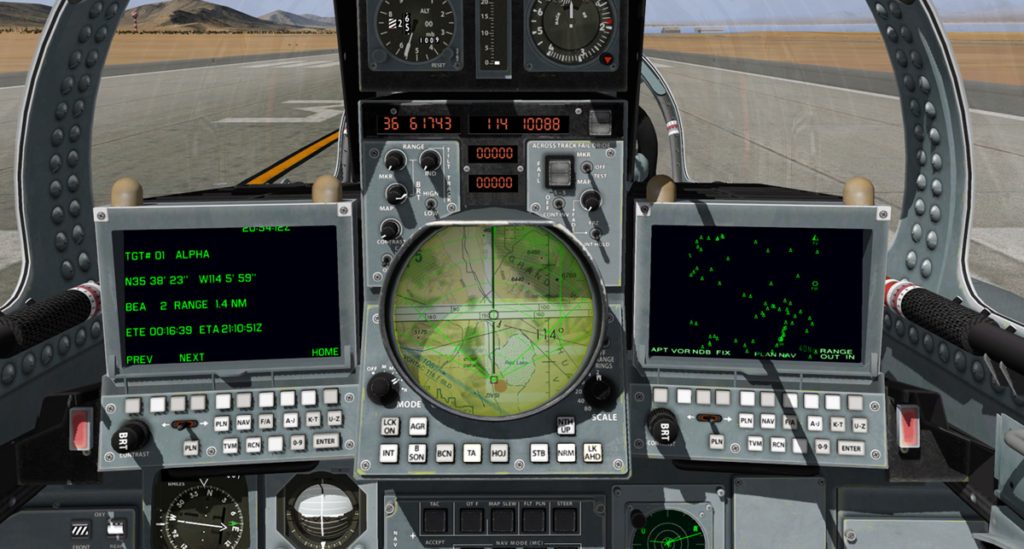 Selecting a pre-briefed target from the back seat.[/caption][caption id=“attachment_7286” align=“aligncenter” width=“362”]
Selecting a pre-briefed target from the back seat.[/caption][caption id=“attachment_7286” align=“aligncenter” width=“362”]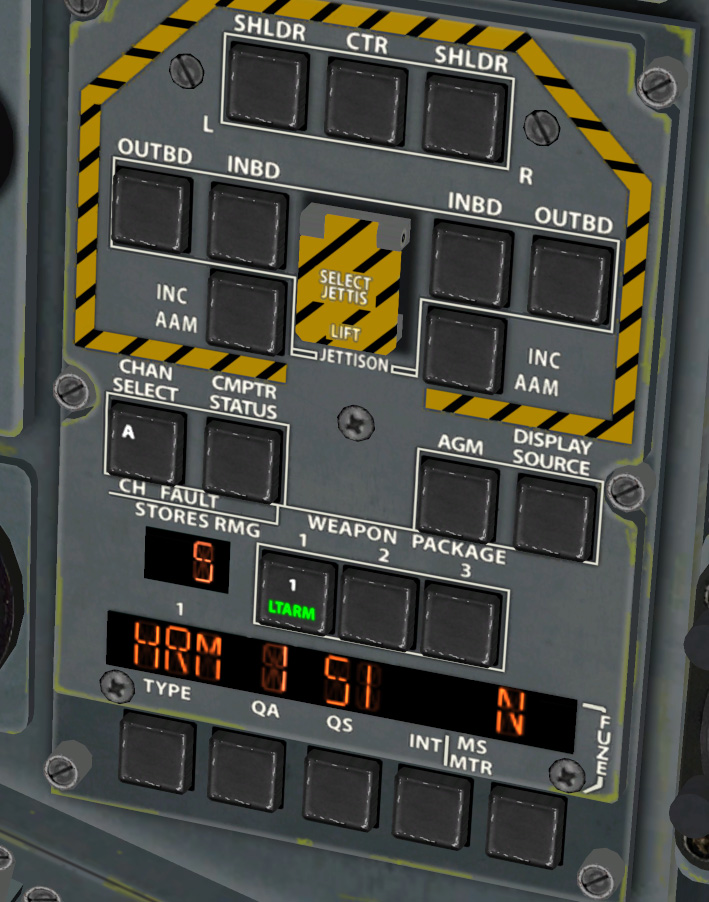 Weapons Configuration Panel[/caption]
Weapons Configuration Panel[/caption]
Bonus features
As if the tanking, map making, target creating, and all of the other things weren’t enough, X-Trident also came up with another interesting plug-in driven tool - the Bliss Back arresting cable system that is installed at many military airfields to allow aircraft equipped with emergency arresting hooks to engage a cable in the event of an emergency situation. The system works great in X-Plane, quickly slowing you to a stop and even showing the animated cable. It is a really nice touch.
## ConclusionThe X-Trident Tornado is a really complete package that seems to be improving with each release, and is probably the most detailed military aircraft we’ve seen brought to X-Plane since their earlier AMX project. While not every knob and system functionality is included, I think they did a very good job of capturing the spirit of the Tornado. The creative use of many plug-ins to add extra content is welcomed and they are not content to sit still as they add further functionality, squash bugs, and look forward to the future, which apparently will include a Harrier project! The dedication to getting as close to reality as they can, along with their constant innovations, puts X-Trident among the top X-Plane add-on developers.
X-Trident Panavia Tornado available at the X-Plane.org store ($38.95US).
Chris “BeachAV8R” Frishmuth

